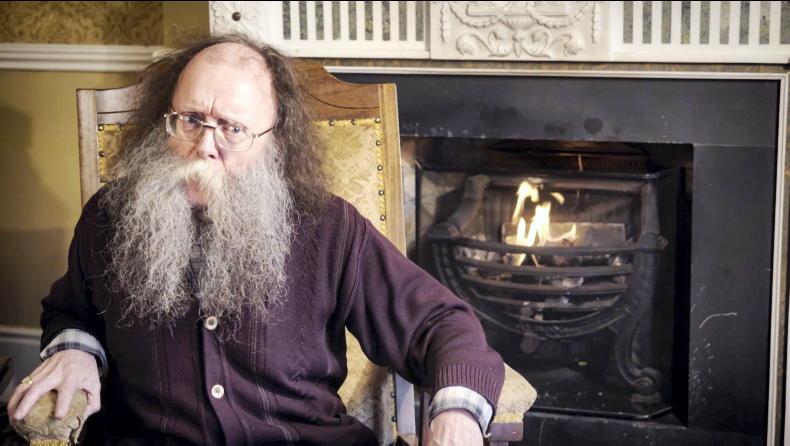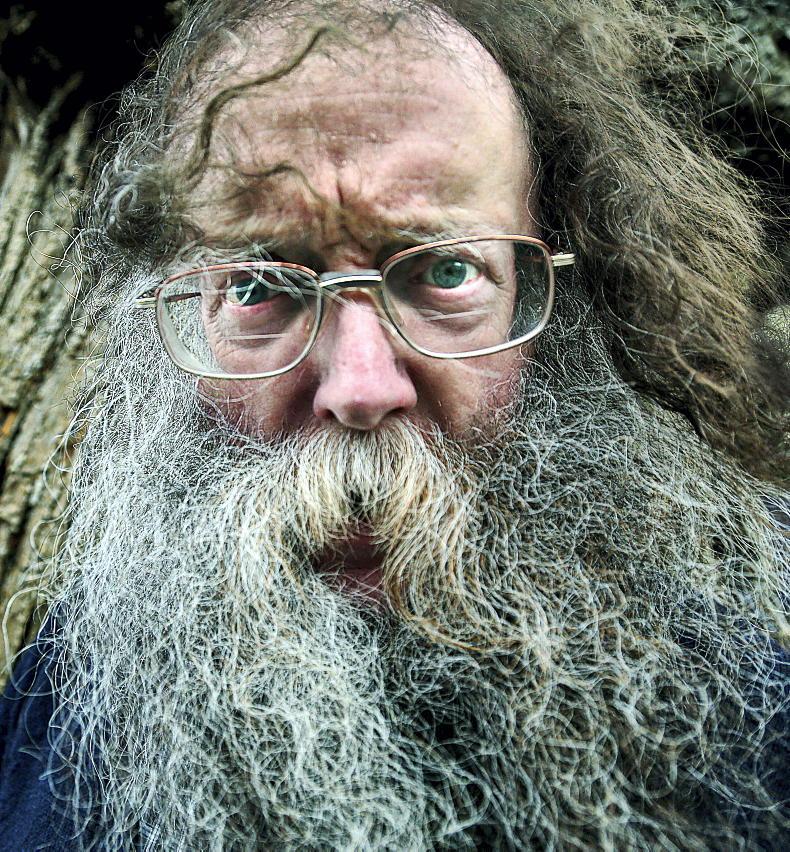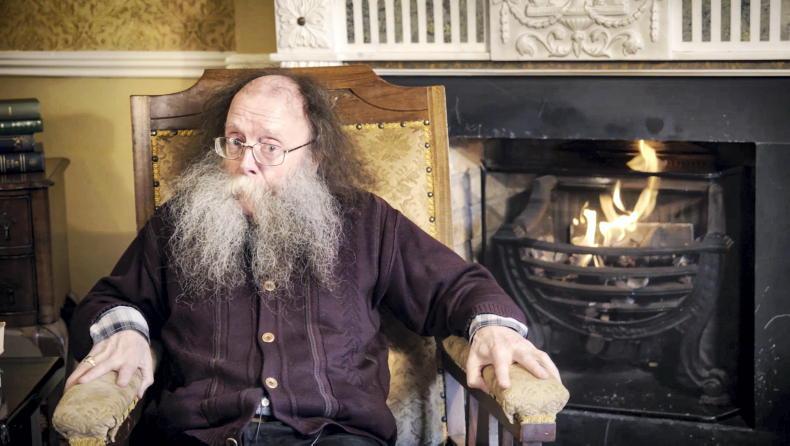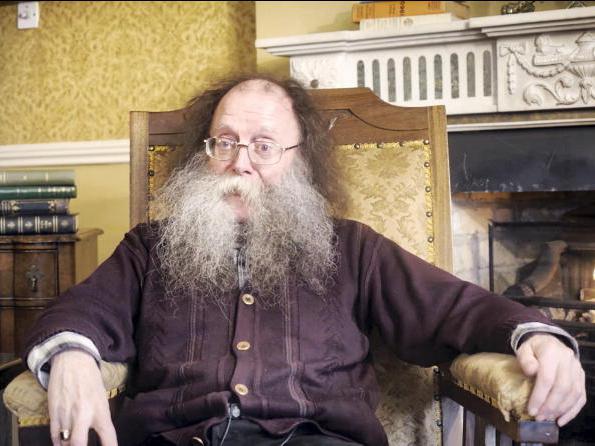Although the conversation flows amiably for a long time, discussing this and that, Eddie Lenihan really comes alive when telling a story. After a period, he regales me with the one overleaf.
When he does, his voice takes on a new quality. There’s an authority to it that captivates. The intonation of his voice and the vernacular he uses, is in a way very comforting, reminding you of someone you knew intimately a long time ago.
This, to be fair, shouldn’t be too surprising, as Eddie is one of Ireland’s most renowned seanchaithe**. A true seanchaí*, as you may know, is rare in this day and age.
Eddie is hugely interested in cultural heritage and folklore. Over the years he has written many books, presented television programmes and started his own podcast, Tell Me A Story.
With such an array of storytelling experience behind him, Irish Country Living wonders how Eddie got into it in the first place. Surely he must come from a long line of seanchaithe?
No, actually.
His father Jack, uncle and grandfather were all harness makers. But, this profession was still important in moulding him into a seanchaí.
From Brosna in Co Kerry, Eddie first went to boarding school in Cork and then moved to secondary school in Abbeyfeale, Co Limerick, after his mother Rachel (neé Morrissey) died. He went on to do a degree in phonetics in NUI Galway. “The only one ever I think to come out of Galway,” he says glibly.
“I had to go out and listen to people, listen to their accents and the words they used. I found out very, very quickly that the stories they told me were every bit as important and interesting as their accents. My father, you see, was the local harness maker in Brosna. As you know, farmers would come in to collect the harness in the shop.

Alongside storytelling at events, writing books, broadcasting and interviewing, Eddie also taught English. \ Jerome Dunne
“So my father, he always had somebody in the shop, talking, telling stories and all the rest of it. Of course, he knew who would be the best man for me to visit. I was introduced to some of the most amazing old people in Brosna parish, people who are long dead. They’d be 130 now if they were alive, some of them. People who were just one step away from the Famine. I remember one man, he was born in 1890.”
Upon inadvertently starting to collect these stories, Eddie knew he wanted to document and tell them, in order to preserve them. This started a lifelong interest in interviewing people and recording their stories on tape. To this day, he has an enormous collection of recordings, which he draws on for his books and other work.
Alongside storytelling at events, writing books, broadcasting and interviewing, Eddie taught English in Laurel Hill Coláiste in Limerick city for 25 years. He now lives in Crusheen, Co Clare.
Fairy stories
In and around the area where Eddie lives in Co Clare, fairies hit the headlines in a big way some years ago. During the bypass of Newmarket-on-Fergus and Ennis, Eddie campaigned that a fairy bush, known as a sceach, would not be demolished to facilitate the road.
It attracted attention from media across the world. In the end, the road was rerouted. The seanchaí says he is not a campaigner in this regard, but simply was trying to avoid road accidents.
“I had heard stories about that bush and I knew if it was disturbed innocent motorists would be killed at that spot, as I had heard of similar things happening in other places. Who wants to hear of tragedies happening if you can do something about it?
“I’ll tell you this, further up the same road, a fairy fort was clipped by the motorway when they were building it. They chopped about a third off a fort and since they did that there have been innumerable accidents just there at that point.”

Renowned storyteller Eddie Lenihan, telling stories of myth and mystery. \ Valerie O'Sullivan
Meeting the Other Crowd is a book Eddie wrote about fairies. He says he rarely gets negative reaction when speaking or telling stories about fairies. But when he does, it’s easy to get around it.
“Irish people are funny – funny-peculiar I mean. Underneath that laughing surface is a seriousness about these things. I’d ask them, ‘If there was a whitethorn bush, would you be the one to cut it? Would you be the one to interfere with a fort?’
“You’ll find they wouldn’t. Most Irish people have heard stories about what has happened to people who have done that kind of thing and nearly always it wasn’t something pleasant.”
A collecting career
Recently, Eddie had been ill. He had two serious operations, which led to him being hospitalised for over a month. “I was lucky I was fit going in,” he explains, “because if I wasn’t, I don’t think I’d be here. Please God we’ll manage from now on, I hope.”
Reflecting on his storytelling, Eddie realises he’d like to have spent more time collecting stories and less time on his other work. This became evident when he could no longer go out and meet people during the pandemic.
“For me, the collecting was the main thing. I always had a list of people I wanted to be visiting. You’d look at your list and you’d always be crossing off people. Another person gone.
“At the end of the year, you didn’t get rich from other things. On the other side then, you didn’t have enough recording done. To me twice as much recording would have been a way more value than twice as much money. Now with COVID-19 here it has only opened my eyes to real values.”
Even though he wishes he had done more collecting of stories, you can be sure Eddie is top-notch at telling them himself too when he gets going.
*Seanchaí – a traditional Irish storyteller.
**Seanchaithe – plural of seanchaí.
Eddie Lenihan shares a Halloween story in his own words:

Author and storyteller Eddie Lenihan reciting a tale by the fireside. \ Jerome Dunne
In Brosna, you’ll still hear sometimes when you’d be playing cards, the phrase when somebody would be having great luck, “Christ, were you under the briars last night?”
Of course, what it means is, an echo of somebody at Halloween crawling under the briars for luck. At midnight on Halloween, if you want to change your luck or you wanted to get very lucky, you find a briar with two roots.
You know yourself, briars, they’re bloody awful to spread, you’d nearly see them growing. If you can find one that’s growing over and around like a little bridge and has taken root a second time, you can crawl under that at the stroke of midnight on Halloween. Just coming out the other side, make your wish and that wish will come true.
There was this man, his luck was out at the cards. He had been losing his shirt nearly and his trousers. He couldn’t get partners to play with him anymore. They used to play the old game, 31, down in Kerry.
But, he found his briar and on Halloween night at midnight, he said he’d chance it. Now there was always one danger, some of the old crowd said you could meet the devil at the other side.
If your luck was bad enough, you’d take your chance.
So out he came, midnight, moonlit night, he made his wish that the cards would improve with him. When he came out the other side, there in the moonlight was a deck of cards. Jesus, he picked them up, put them in his pocket and ran for home.
Well, there was nobody up. Over to the fireplace, he took out the deck and it seemed to be an ordinary deck of cards.
A couple of nights later there was a game of cards. It was all house games that time, sure they hadn’t the price of the pub, even though pints were cheap.
He went in anyway and said, “Lads, we’ll play with this deck tonight” and by God he did. Every game that night he won. Of course the boys were examining the deck, “What in the name of Christ kind of deck is this?” They couldn’t believe it, and he hadn’t been wining for what? Two months before that!
He was winning and the stakes weren’t big, but to be winning tuppence or six pence a game, still. They were flabbergasted and he was delighted. It was the same thing the next Tuesday night and the next and the next. Of course, the murmurs went around and the murmurs made their way to the presbytery. The Parish Priest, “Bring the deck. Devil’s prayer book”.
By God, he wasn’t going to bring the deck. It was valuable property. Hi, he legged it, legged it back to Tralee and the same there. He cleaned them, cleaned them entirely. The Parish Priest sent a message back there, “Bring it, it’s dangerous property”.
Faith, he legged it to Killarney and the same thing there. Of course in Killarney, the Bishop. The Bishop sent for him, “Come on”. Of course that was big talk from the Bishop. By Jesus, he had to run for it to Dublin.
In Dublin, oh big clubs there. Wasn’t he invited into one of the clubs, they examined the deck and said, “A country hick from Kerry”. They were going to clean him. He had a bit of money saved up at this stage, a few gold sovereigns. They invited him into one of these clubs in one of these Georgian houses. He cleaned them.
He made his way to London, same story, and was invited over to one of the salons in Paris. For the next several years it was the same thing there. He became a friend of Louis XVI.
Jesus, quite entirely he was done up in silks and satins, mighty stuff altogether. The years passed and he became a count of some description.
But like I say, the years passed, and it came time for him to pass to a better place. But, the Padre wouldn’t give him the final absolution without him handing over this wonderful thing we know about; he wouldn’t give it without the deck.
So he had to hand over the deck. He got his, “In nomine Patris, et Filii, et Spiritus Sancti, Amen” and lay back on the pillows. But when the deck was examined by the Padre, turned over, the strange thing about it was every bloody card was a joker. What do you think was on the last joker?
The devil’s face and two horns above.
I can tell you, wasn’t he lucky he’d gotten, “In nomine Patris, et Filii, et Spiritus Sancti, Amen” before the devil had gotten a hold of him. Well, the devil went out the door in a cloud of smoke and fire and screech out of him.
He had been cheated, after all the favours he had done the man, he hadn’t gotten his reward.
But, you couldn’t fool a Kerry man!
A true story.
Read more
From ringforts to fairies: the influence of Irish folklore on farming
Although the conversation flows amiably for a long time, discussing this and that, Eddie Lenihan really comes alive when telling a story. After a period, he regales me with the one overleaf.
When he does, his voice takes on a new quality. There’s an authority to it that captivates. The intonation of his voice and the vernacular he uses, is in a way very comforting, reminding you of someone you knew intimately a long time ago.
This, to be fair, shouldn’t be too surprising, as Eddie is one of Ireland’s most renowned seanchaithe**. A true seanchaí*, as you may know, is rare in this day and age.
Eddie is hugely interested in cultural heritage and folklore. Over the years he has written many books, presented television programmes and started his own podcast, Tell Me A Story.
With such an array of storytelling experience behind him, Irish Country Living wonders how Eddie got into it in the first place. Surely he must come from a long line of seanchaithe?
No, actually.
His father Jack, uncle and grandfather were all harness makers. But, this profession was still important in moulding him into a seanchaí.
From Brosna in Co Kerry, Eddie first went to boarding school in Cork and then moved to secondary school in Abbeyfeale, Co Limerick, after his mother Rachel (neé Morrissey) died. He went on to do a degree in phonetics in NUI Galway. “The only one ever I think to come out of Galway,” he says glibly.
“I had to go out and listen to people, listen to their accents and the words they used. I found out very, very quickly that the stories they told me were every bit as important and interesting as their accents. My father, you see, was the local harness maker in Brosna. As you know, farmers would come in to collect the harness in the shop.

Alongside storytelling at events, writing books, broadcasting and interviewing, Eddie also taught English. \ Jerome Dunne
“So my father, he always had somebody in the shop, talking, telling stories and all the rest of it. Of course, he knew who would be the best man for me to visit. I was introduced to some of the most amazing old people in Brosna parish, people who are long dead. They’d be 130 now if they were alive, some of them. People who were just one step away from the Famine. I remember one man, he was born in 1890.”
Upon inadvertently starting to collect these stories, Eddie knew he wanted to document and tell them, in order to preserve them. This started a lifelong interest in interviewing people and recording their stories on tape. To this day, he has an enormous collection of recordings, which he draws on for his books and other work.
Alongside storytelling at events, writing books, broadcasting and interviewing, Eddie taught English in Laurel Hill Coláiste in Limerick city for 25 years. He now lives in Crusheen, Co Clare.
Fairy stories
In and around the area where Eddie lives in Co Clare, fairies hit the headlines in a big way some years ago. During the bypass of Newmarket-on-Fergus and Ennis, Eddie campaigned that a fairy bush, known as a sceach, would not be demolished to facilitate the road.
It attracted attention from media across the world. In the end, the road was rerouted. The seanchaí says he is not a campaigner in this regard, but simply was trying to avoid road accidents.
“I had heard stories about that bush and I knew if it was disturbed innocent motorists would be killed at that spot, as I had heard of similar things happening in other places. Who wants to hear of tragedies happening if you can do something about it?
“I’ll tell you this, further up the same road, a fairy fort was clipped by the motorway when they were building it. They chopped about a third off a fort and since they did that there have been innumerable accidents just there at that point.”

Renowned storyteller Eddie Lenihan, telling stories of myth and mystery. \ Valerie O'Sullivan
Meeting the Other Crowd is a book Eddie wrote about fairies. He says he rarely gets negative reaction when speaking or telling stories about fairies. But when he does, it’s easy to get around it.
“Irish people are funny – funny-peculiar I mean. Underneath that laughing surface is a seriousness about these things. I’d ask them, ‘If there was a whitethorn bush, would you be the one to cut it? Would you be the one to interfere with a fort?’
“You’ll find they wouldn’t. Most Irish people have heard stories about what has happened to people who have done that kind of thing and nearly always it wasn’t something pleasant.”
A collecting career
Recently, Eddie had been ill. He had two serious operations, which led to him being hospitalised for over a month. “I was lucky I was fit going in,” he explains, “because if I wasn’t, I don’t think I’d be here. Please God we’ll manage from now on, I hope.”
Reflecting on his storytelling, Eddie realises he’d like to have spent more time collecting stories and less time on his other work. This became evident when he could no longer go out and meet people during the pandemic.
“For me, the collecting was the main thing. I always had a list of people I wanted to be visiting. You’d look at your list and you’d always be crossing off people. Another person gone.
“At the end of the year, you didn’t get rich from other things. On the other side then, you didn’t have enough recording done. To me twice as much recording would have been a way more value than twice as much money. Now with COVID-19 here it has only opened my eyes to real values.”
Even though he wishes he had done more collecting of stories, you can be sure Eddie is top-notch at telling them himself too when he gets going.
*Seanchaí – a traditional Irish storyteller.
**Seanchaithe – plural of seanchaí.
Eddie Lenihan shares a Halloween story in his own words:

Author and storyteller Eddie Lenihan reciting a tale by the fireside. \ Jerome Dunne
In Brosna, you’ll still hear sometimes when you’d be playing cards, the phrase when somebody would be having great luck, “Christ, were you under the briars last night?”
Of course, what it means is, an echo of somebody at Halloween crawling under the briars for luck. At midnight on Halloween, if you want to change your luck or you wanted to get very lucky, you find a briar with two roots.
You know yourself, briars, they’re bloody awful to spread, you’d nearly see them growing. If you can find one that’s growing over and around like a little bridge and has taken root a second time, you can crawl under that at the stroke of midnight on Halloween. Just coming out the other side, make your wish and that wish will come true.
There was this man, his luck was out at the cards. He had been losing his shirt nearly and his trousers. He couldn’t get partners to play with him anymore. They used to play the old game, 31, down in Kerry.
But, he found his briar and on Halloween night at midnight, he said he’d chance it. Now there was always one danger, some of the old crowd said you could meet the devil at the other side.
If your luck was bad enough, you’d take your chance.
So out he came, midnight, moonlit night, he made his wish that the cards would improve with him. When he came out the other side, there in the moonlight was a deck of cards. Jesus, he picked them up, put them in his pocket and ran for home.
Well, there was nobody up. Over to the fireplace, he took out the deck and it seemed to be an ordinary deck of cards.
A couple of nights later there was a game of cards. It was all house games that time, sure they hadn’t the price of the pub, even though pints were cheap.
He went in anyway and said, “Lads, we’ll play with this deck tonight” and by God he did. Every game that night he won. Of course the boys were examining the deck, “What in the name of Christ kind of deck is this?” They couldn’t believe it, and he hadn’t been wining for what? Two months before that!
He was winning and the stakes weren’t big, but to be winning tuppence or six pence a game, still. They were flabbergasted and he was delighted. It was the same thing the next Tuesday night and the next and the next. Of course, the murmurs went around and the murmurs made their way to the presbytery. The Parish Priest, “Bring the deck. Devil’s prayer book”.
By God, he wasn’t going to bring the deck. It was valuable property. Hi, he legged it, legged it back to Tralee and the same there. He cleaned them, cleaned them entirely. The Parish Priest sent a message back there, “Bring it, it’s dangerous property”.
Faith, he legged it to Killarney and the same thing there. Of course in Killarney, the Bishop. The Bishop sent for him, “Come on”. Of course that was big talk from the Bishop. By Jesus, he had to run for it to Dublin.
In Dublin, oh big clubs there. Wasn’t he invited into one of the clubs, they examined the deck and said, “A country hick from Kerry”. They were going to clean him. He had a bit of money saved up at this stage, a few gold sovereigns. They invited him into one of these clubs in one of these Georgian houses. He cleaned them.
He made his way to London, same story, and was invited over to one of the salons in Paris. For the next several years it was the same thing there. He became a friend of Louis XVI.
Jesus, quite entirely he was done up in silks and satins, mighty stuff altogether. The years passed and he became a count of some description.
But like I say, the years passed, and it came time for him to pass to a better place. But, the Padre wouldn’t give him the final absolution without him handing over this wonderful thing we know about; he wouldn’t give it without the deck.
So he had to hand over the deck. He got his, “In nomine Patris, et Filii, et Spiritus Sancti, Amen” and lay back on the pillows. But when the deck was examined by the Padre, turned over, the strange thing about it was every bloody card was a joker. What do you think was on the last joker?
The devil’s face and two horns above.
I can tell you, wasn’t he lucky he’d gotten, “In nomine Patris, et Filii, et Spiritus Sancti, Amen” before the devil had gotten a hold of him. Well, the devil went out the door in a cloud of smoke and fire and screech out of him.
He had been cheated, after all the favours he had done the man, he hadn’t gotten his reward.
But, you couldn’t fool a Kerry man!
A true story.
Read more
From ringforts to fairies: the influence of Irish folklore on farming









 This is a subscriber-only article
This is a subscriber-only article










SHARING OPTIONS: